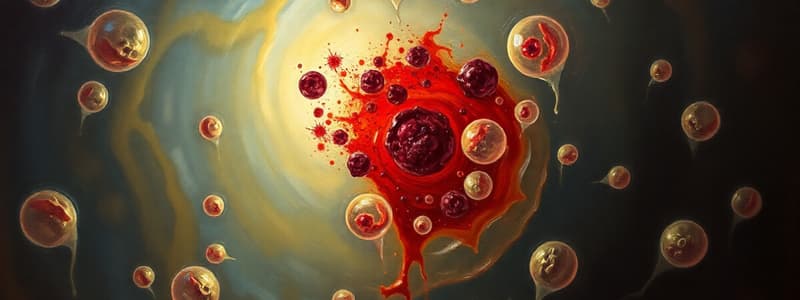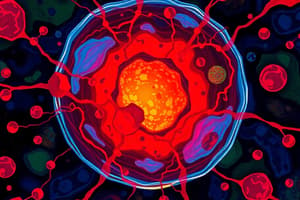Podcast
Questions and Answers
What characterizes necrosis as a form of cell death?
What characterizes necrosis as a form of cell death?
- Cell swelling and organellar breakdown (correct)
- Increased membrane integrity
- Programmed cell death
- Cell shrinkage and apoptosis
How does hypoxia contribute to cell injury?
How does hypoxia contribute to cell injury?
- By increasing cell membrane permeability
- By causing inadequate blood oxygenation (correct)
- By improving nutrient absorption
- By enhancing aerobic respiration
Which of the following is NOT a cause of cell injury?
Which of the following is NOT a cause of cell injury?
- Increased oxygenation (correct)
- Genetic defects
- Physical agents
- Nutritional imbalances
Which intracellular system is NOT identified as vulnerable to injury?
Which intracellular system is NOT identified as vulnerable to injury?
What is a common consequence of aging related to cell injury?
What is a common consequence of aging related to cell injury?
Which type of cell death does apoptosis represent?
Which type of cell death does apoptosis represent?
Which factor is crucial in determining the severity of cell injury?
Which factor is crucial in determining the severity of cell injury?
What role does cytosolic free calcium play in cell injury?
What role does cytosolic free calcium play in cell injury?
What is fat necrosis primarily associated with?
What is fat necrosis primarily associated with?
Which of the following statements about apoptosis is true?
Which of the following statements about apoptosis is true?
What can happen to normal cells in terms of intracellular accumulations?
What can happen to normal cells in terms of intracellular accumulations?
What is NOT a mechanism that initiates apoptosis?
What is NOT a mechanism that initiates apoptosis?
How does apoptosis typically present histologically?
How does apoptosis typically present histologically?
What is a characteristic feature of karyorrhexis in apoptosis?
What is a characteristic feature of karyorrhexis in apoptosis?
Which of these categories best describes intracellular accumulation of a normal endogenous substance?
Which of these categories best describes intracellular accumulation of a normal endogenous substance?
What type of cell death is characterized by cell shrinkage and fragmentation into apoptotic bodies?
What type of cell death is characterized by cell shrinkage and fragmentation into apoptotic bodies?
What is the primary cause of cytoplasmic eosinophilia?
What is the primary cause of cytoplasmic eosinophilia?
Which type of necrosis is characterized by preservation of the structural outlines of the coagulated cells?
Which type of necrosis is characterized by preservation of the structural outlines of the coagulated cells?
What is karyolysis primarily caused by?
What is karyolysis primarily caused by?
Which of the following correctly describes liquefactive necrosis?
Which of the following correctly describes liquefactive necrosis?
What contributes to the glassy appearance of cytoplasmic changes in necrosis?
What contributes to the glassy appearance of cytoplasmic changes in necrosis?
What is the main difference between autolysis and heterolysis in necrosis?
What is the main difference between autolysis and heterolysis in necrosis?
Gangrenous necrosis refers to what conditions?
Gangrenous necrosis refers to what conditions?
Which of the following is a characteristic of caseous necrosis?
Which of the following is a characteristic of caseous necrosis?
What is the primary consequence of excessive triglyceride accumulation in parenchymal cells?
What is the primary consequence of excessive triglyceride accumulation in parenchymal cells?
Which factor does NOT contribute to fatty change (steatosis)?
Which factor does NOT contribute to fatty change (steatosis)?
How do xanthomas typically appear in subcutaneous connective tissues?
How do xanthomas typically appear in subcutaneous connective tissues?
Which of the following is NOT a cause of pathological calcification?
Which of the following is NOT a cause of pathological calcification?
What type of pigments are classified as colored substances that can accumulate in tissues?
What type of pigments are classified as colored substances that can accumulate in tissues?
What characterizes the appearance of liver tissue under a light microscope when fatty change occurs?
What characterizes the appearance of liver tissue under a light microscope when fatty change occurs?
What type of cells become filled with lipid when they phagocytize necrotic debris, leading to their foamy appearance?
What type of cells become filled with lipid when they phagocytize necrotic debris, leading to their foamy appearance?
Which of the following best describes the cause of glycogen accumulation in tissue?
Which of the following best describes the cause of glycogen accumulation in tissue?
What is dystrophic calcification characterized by?
What is dystrophic calcification characterized by?
Which condition is NOT a cause of hypercalcemia?
Which condition is NOT a cause of hypercalcemia?
Where does metastatic calcification typically occur?
Where does metastatic calcification typically occur?
What leads to atrophy of cells?
What leads to atrophy of cells?
What defines hypertrophy in cellular adaptations?
What defines hypertrophy in cellular adaptations?
What is a common characteristic of pathologic adaptations?
What is a common characteristic of pathologic adaptations?
What occurs during atrophy at the biochemical level?
What occurs during atrophy at the biochemical level?
What symptom is commonly associated with extensive nephrocalcinosis?
What symptom is commonly associated with extensive nephrocalcinosis?
Flashcards are hidden until you start studying
Study Notes
Cell Injury
- Cells try to maintain a stable internal environment.
- When cells are exposed to stress or harmful stimuli, they can adapt to preserve viability.
- If adaptation fails, cell injury develops.
Cell Death
- Necrosis: Cell death triggered by harmful agents, characterized by swelling, protein breakdown, and organelle damage.
- Apoptosis: Programmed cell death, occurring under normal or physiological conditions.
Causes of Cell Injury
- Hypoxia: Insufficient oxygen supply.
- Ischemia: Reduced blood flow, leading to hypoxia.
- Physical agents: Trauma, temperature extremes, radiation, electric shock, atmospheric pressure changes.
- Chemicals and drugs: Alter membrane permeability, disrupt osmotic balance, affect enzyme function.
- Microbiologic agents: Viruses, bacteria, parasites.
- Immunologic reactions: Immune system responses causing cell injury.
- Genetic defects: Inherited conditions like Down's syndrome or sickle cell anemia.
- Nutritional imbalances: Protein-calorie deficiency, vitamin deficiencies, high animal fat intake.
- Aging: Cellular aging contributes to vulnerability to injury.
Mechanisms of Cell Injury
- The severity and type of injury influence the cell's response.
- The cell's type, health status, and adaptability affect the outcome.
- Vulnerable intracellular systems: Cell membrane integrity, aerobic respiration, protein synthesis, genetic apparatus.
- Cytoplasmic Eosinophilia: Due to cytoplasmic acidosis and ribosome loss.
- Fatty Change: Accumulation of fat within cells, often seen in liver cells due to hypoxia or chemical injury.
Ultrastructural Changes
- Plasma membrane: Blebbing, microvilli distortion, loosened cell connections.
- Mitochondria: Swelling, appearance of phospholipid-rich densities.
- Endoplasmic reticulum: Dilatation, detachment of ribosomes, polysome dissociation.
- Nuclear alterations: Disaggregation of granular elements.
Necrosis
- Characterized by a series of morphological changes following cell death in living tissue.
- Results from enzyme digestion of the cell and protein denaturation.
- Cytoplasmic changes: Eosinophilia, loss of glycogen, vacuolation, and calcification.
- Nuclear changes:
- Karyolysis: DNA digestion.
- Pyknosis: Nuclear shrinkage with increased basophilia, primarily seen in apoptosis.
- Karyorrhexis: Fragmentation of the pyknotic nucleus.
Types of Necrosis
- Coagulative necrosis: Preservation of cell structure with coagulated proteins.
- Common in myocardial infarction, appearing as acidophilic coagulated anucleated cells.
- Liquefactive necrosis: Occurs due to bacterial or fungal infection, with white blood cell accumulation.
- Gangrenous necrosis: Ischemic coagulative necrosis superimposed with infection and liquefaction.
- Caseous necrosis: Associated with tuberculosis infections, characterized by cheesy, white appearance.
- Fat necrosis: Focal fat destruction due to pancreatitis, resulting from activated pancreatic enzymes.
Apoptosis
- Programmed cell death, occurring in various physiological and pathological situations.
- Examples: Embryonic development, hormone-dependent involution, cell removal in proliferating populations, deletion of autoreactive T cells.
- Morphological features: Round masses with eosinophilic cytoplasm and condensed nuclear chromatin.
- Process: Cell shrinkage, cytoplasmic budding, fragmentation into apoptotic bodies.
- Does not elicit an inflammatory response
- Initiation:
- Withdrawal of growth factors or hormones.
- Engagement of specific receptors (e.g., FAS, TNF).
- Injury by radiation, toxins, and free radicals.
- Intrinsic protease activation (e.g., in embryogenesis).
Intracellular Accumulations
- Cells may accumulate abnormal substances either transiently or permanently.
- Accumulation may affect cell function or be harmless.
- Categories:
- Normal endogenous substance produced at an increased rate.
- Normal or abnormal endogenous substance that cannot be metabolized due to genetic enzyme defects.
- Abnormal exogenous substances, causing accumulation because the cell cannot metabolize or transport them.
Fatty Change (Steatosis)
- Abnormal accumulation of triglycerides within cells, mainly in the liver.
- Causes: Toxins, diabetes, protein malnutrition, obesity, anoxia.
- Consequences: May impair cellular function.
- Grossly: Liver enlarges and turns yellow.
Cholesterol and Cholesterol Esters
- Macrophages engulf lipid debris from necrotic cells, appearing as foamy cells.
- Atheromas: Smooth muscle cells and macrophages filled with lipid vacuoles.
- Xanthomas: Fat accumulation within macrophages of subcutaneous connective tissues.
Proteins
- Accumulation in cells can occur in conditions like glomerular diseases.
Glycogen
- Accumulates in cases of abnormal glucose or glycogen metabolism.
Pigments
- Colored substances, either exogenous or endogenous.
- Melanin: Brown pigment, accumulating in skin cells, causing freckles.
- Hemosiderin: Golden brown pigment, accumulates in tissues with iron overload.
Pathologic Calcification
- Abnormal accumulation of calcium salts, often with other minerals.
- Dystrophic calcification: Occurs in dead or dying tissues, despite normal calcium serum levels.
- Metastatic calcification: Occurs in normal tissues when calcium levels are high in the blood.
- Causes: Hyperparathyroidism, certain cancers, disorders like sarcoidosis, and advanced renal failure.
Cellular Adaptations of Growth and Differentiation
- Cells adapt to stimuli in response to normal or abnormal conditions.
- Atrophy: Shrinking of cells due to loss of cell substance.
- Causes: Decreased workload, denervation, blood supply issues, malnutrition, age.
- Hypertrophy: Increase in cell size due to increased protein synthesis and organelle production.
Studying That Suits You
Use AI to generate personalized quizzes and flashcards to suit your learning preferences.




